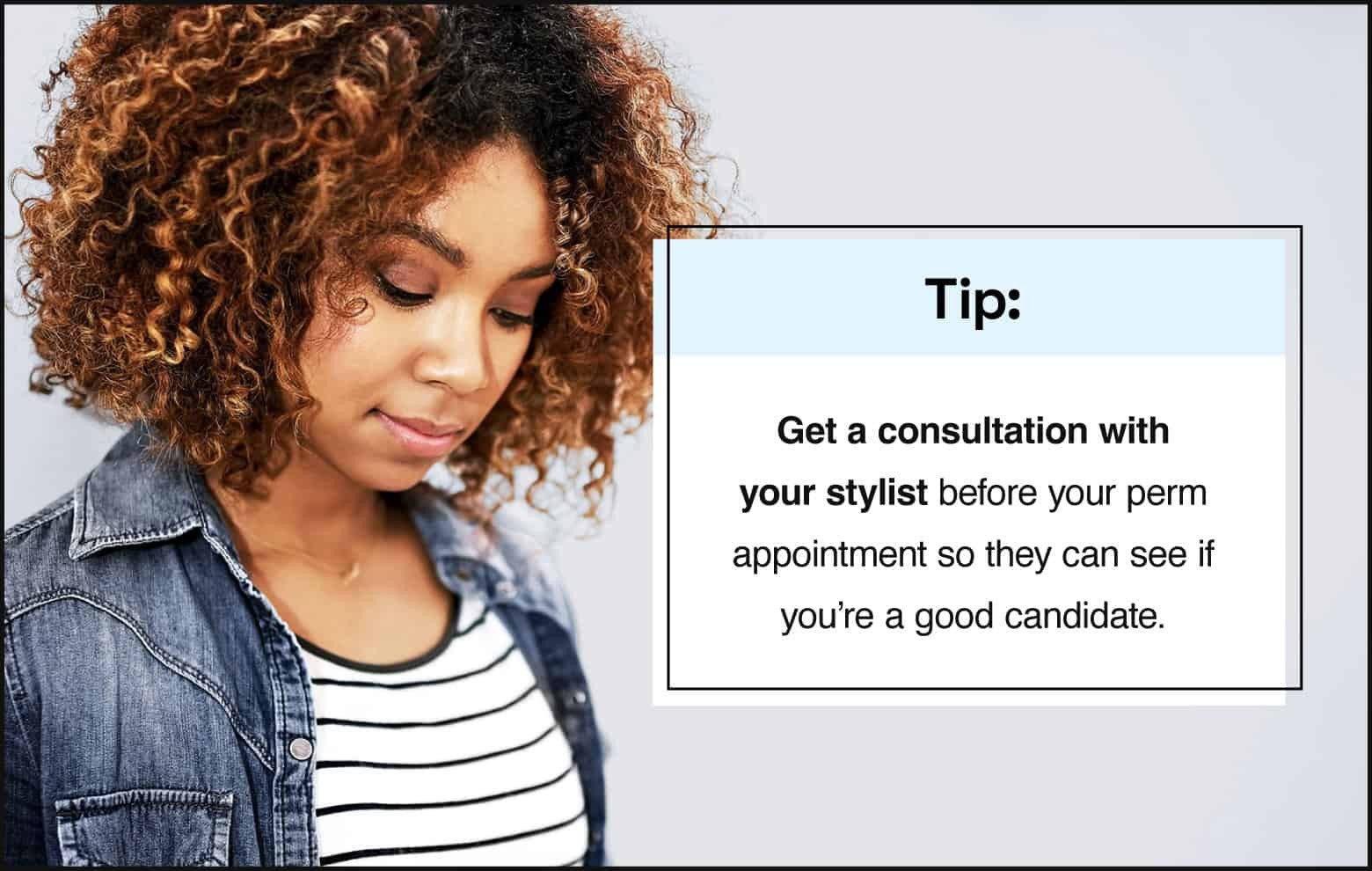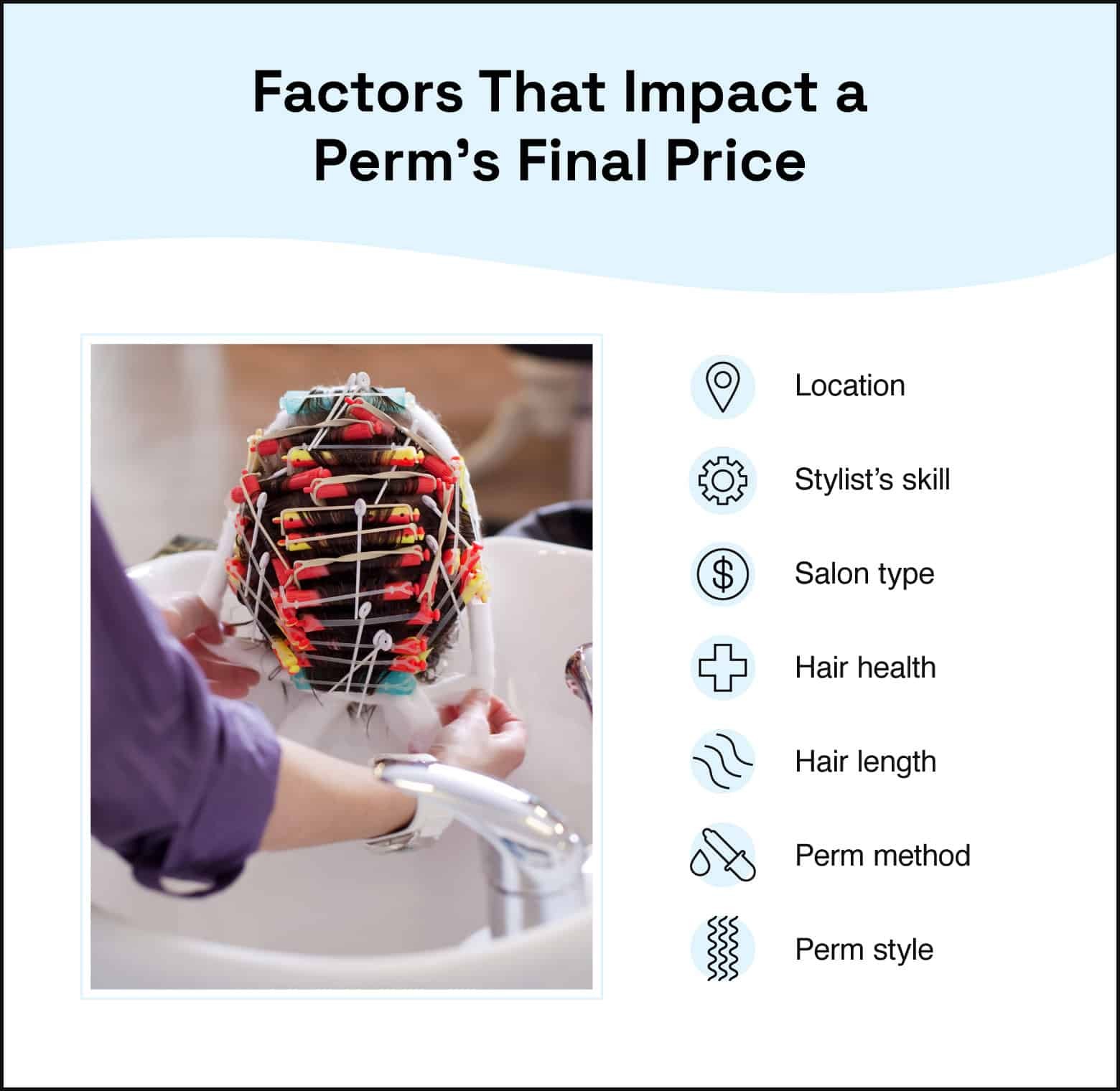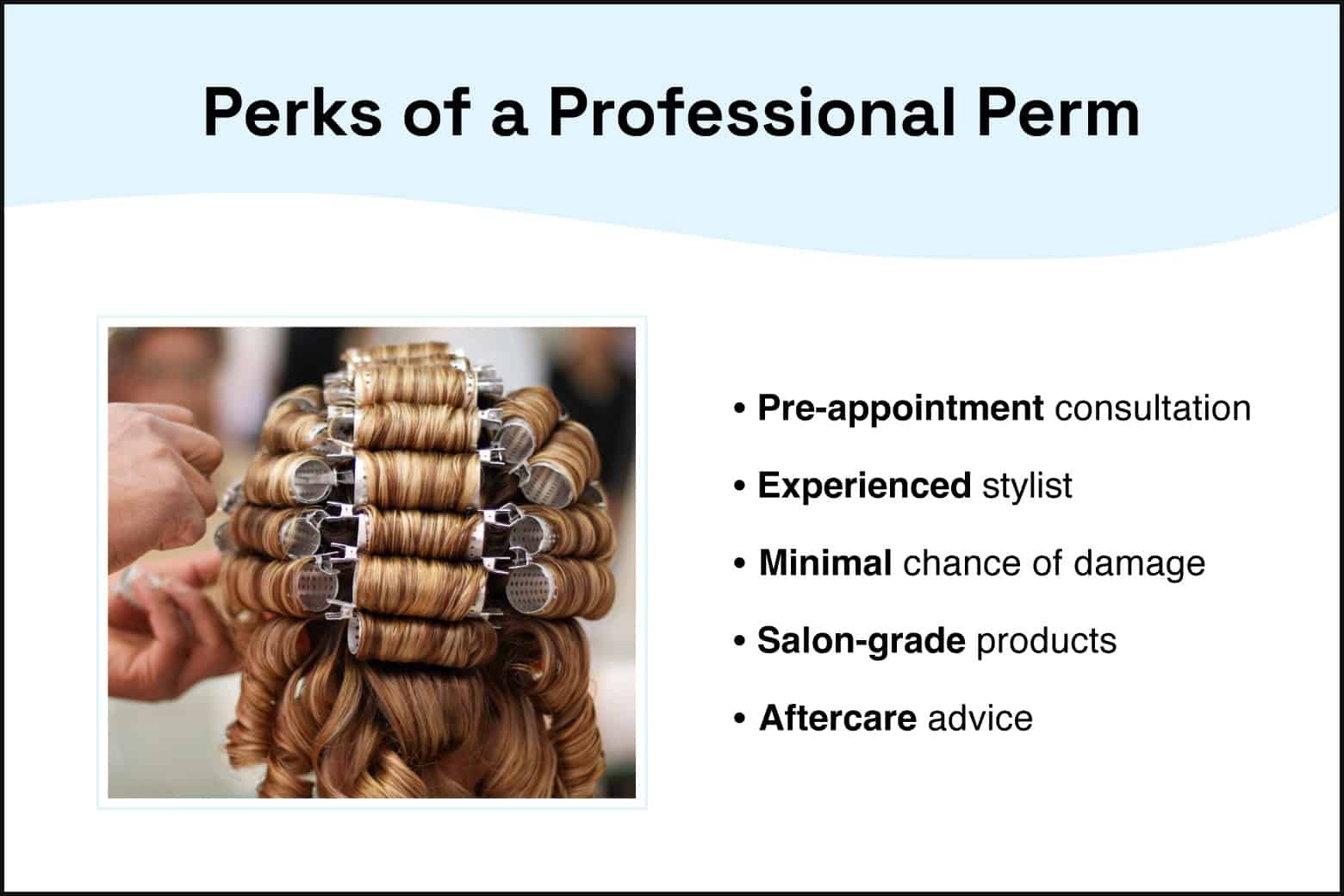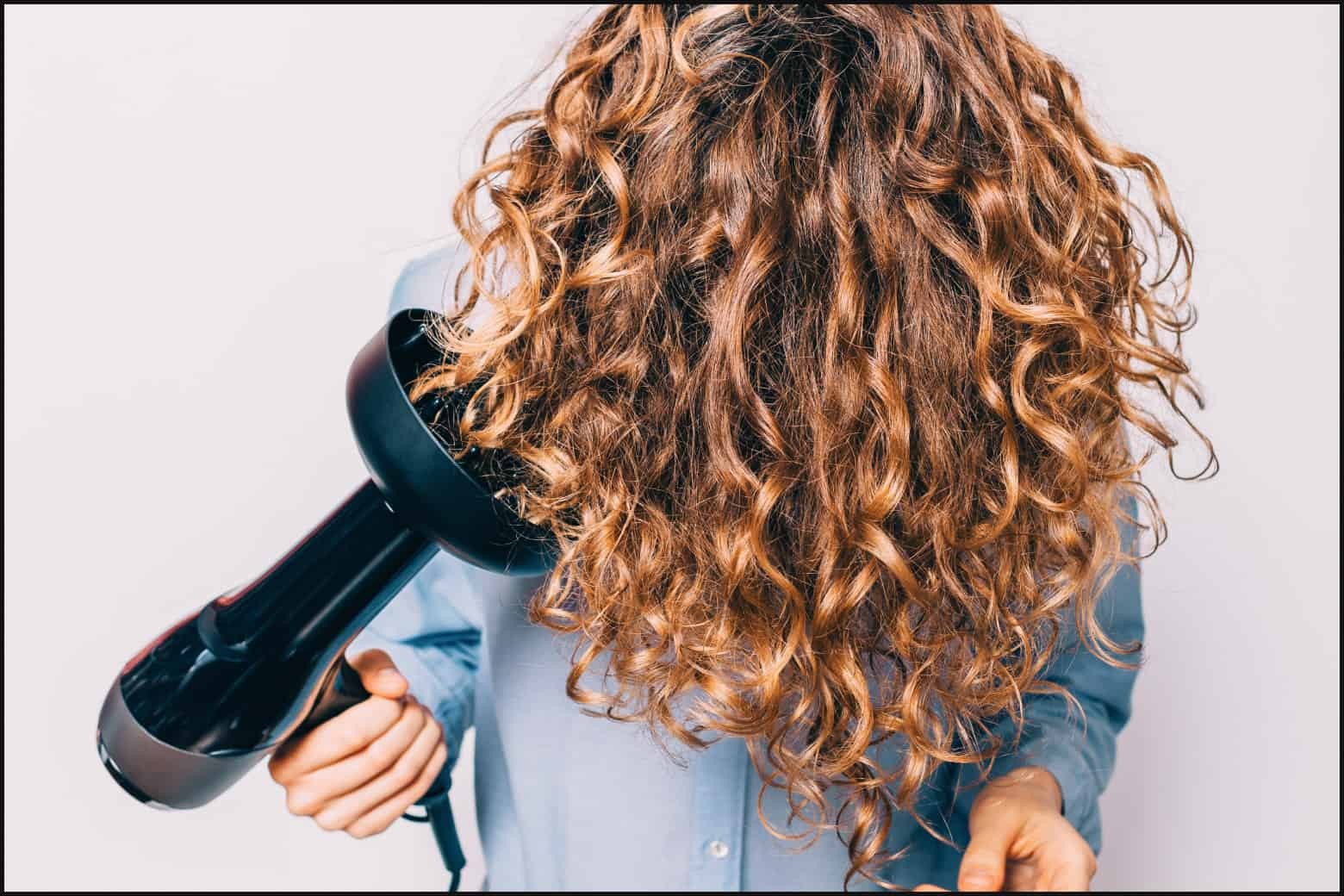How Much Do Perms Cost? The cost of a perm can vary significantly, and at HOW.EDU.VN, we understand that you need accurate information to make informed decisions. This guide explores the factors influencing perm pricing, helping you understand the investment involved in achieving your desired curl pattern. Discover expert insights and personalized guidance to ensure you receive the best value and achieve stunning results. We’ll also touch upon associated hair treatments, salon costs, and professional hair styling.
1. Understanding Perm Costs: An In-Depth Look
The price of a perm can range from $30 to $800, influenced by various factors. Understanding these elements is key to budgeting and finding the best value. Let’s delve into these factors to give you a clearer picture of the financial aspects involved.
1.1 Hair Length and Perm Costs
Hair length is a primary factor determining the price of a perm. Shorter hair requires less product and time, resulting in lower costs. Conversely, longer hair demands more product, time, and meticulous attention, increasing the overall expense.
| Hair Length | Average Perm Cost | Considerations |
|---|---|---|
| Short | $30 – $150 | Less product, faster application, fewer rods needed. |
| Medium | $60 – $200 | Moderate product usage, average prep time, standard number of rods. |
| Long | $80 – $400 | Extensive product required, longer prep time, detailed process to ensure even curl. |




1.2 Perming Methods and Their Prices
Different perming methods utilize various chemicals, application techniques, and tools, each affecting the final cost. The complexity and precision required for each method play a significant role in pricing.
- Acid or Hot Perms: These perms use glyceryl monothioglycolate and heat to reshape hair. While gentle, they can be more time-consuming, influencing the cost.
- Alkaline or Cold Perms: Utilizing ammonium thioglycolate, these perms create long-lasting curls without heat. They are generally more affordable but not suitable for all hair types.
- Digital Perms: Employing digital perm rods for precise heat control, these are excellent for defined curls but come with a higher price due to specialized equipment.
- Exothermic Perms: These perms use a chemical reaction to generate heat, opening the hair shaft for curling. They are effective for resistant hair but may add to the cost.
- Dual-Action Perms: Softening and smoothing hair before curling, these require a multi-step process, affecting the price.
- Organic Perms: Using natural oils and chemical-free solutions, these are a gentler option that might be priced higher due to specialized products.
1.3 Popular Perm Styles and Cost Variations
Various perm styles require different techniques, influencing the overall cost. From spiral perms to beach waves, each style demands a unique approach, impacting the final price.
| Perm Style | Average Cost | Description |
|---|---|---|
| Root Perm | $30 – $80 | Adds volume at the roots, ideal for shorter hair. |
| Spot/Partial Perm | $30 – $100 | Adds curls to specific sections, perfect for targeted volume or curl enhancement. |
| Volumizing Perm | $40 – $150 | Creates soft waves and overall volume, a subtle enhancement. |
| Body Wave Perm | $40 – $200 | Produces soft, natural-looking waves for a relaxed style. |
| Beach Wave Perm | $40 – $200 | Mimics the tousled waves from a day at the beach, ideal for longer hair. |
| Stacked/Multi-Textured | $40 – $250 | Uses a stack of perm rods to create varied curl patterns, low maintenance. |
| Straight Perm | $30 – $400 | Permanently straightens hair, also known as a reverse perm. |
| Spiral Perm | $45 – $200 | Creates tight, bouncy curls with a natural look. |
| Weave Perm | $70 – $110 | Adds waves and body throughout the hair for increased volume. |
1.4 Additional Factors Affecting Perm Costs
Beyond hair length and style, several other factors can influence the final cost of your perm. Awareness of these can help you anticipate and plan for the overall expense.
- Location: Salons in areas with a high cost of living typically charge more.
- Stylist’s Expertise: Experienced stylists often command higher prices for their skills.
- Salon Type: High-end salons generally have higher prices due to overhead and luxury services.
- Hair Condition: If your hair requires additional treatments to prepare for a perm, the cost will increase.
2. Preparing for Your Perm: Key Considerations
Before diving into a perm, it’s essential to consider several factors to ensure you’re a suitable candidate and will achieve the desired results. This preparation can greatly influence the outcome and longevity of your perm.
2.1 Assessing Your Hair’s Health
Healthy hair is crucial for a successful perm. Damaged or overly processed hair may not withstand the chemical treatment, leading to unsatisfactory results or further damage.
- Chemical Treatments: Recent bleaching, coloring, or straightening treatments can weaken hair. Consult your stylist about the best course of action.
- Hair Strength: Strong, resilient hair is ideal. Use protein treatments or strengthening masks to prepare your hair.
- Overall Condition: Dry, brittle, or split ends should be addressed with deep conditioning treatments before perming.
2.2 Determining Your Hair Length Suitability
Sufficient hair length is necessary to wrap around perm rods and create curls effectively. Too short hair may limit styling options and prevent desired results.
- Minimum Length: Aim for at least a couple of inches of hair to ensure proper wrapping around the rods.
- Desired Style: Longer hair allows for more versatile wave and curl styles.
- Layering: Layers can affect the perm’s outcome, potentially requiring extra effort and cost.
2.3 Lifestyle Considerations
Your lifestyle can impact the longevity and maintenance of your perm. Certain activities and environmental factors can affect the health and appearance of your permed hair.
- Swimming: Chlorine can damage permed hair, so frequent swimmers should take precautions or consider alternative styles.
- Maintenance: Be prepared for regular conditioning, moisturizing, and specialized hair care products.
- Styling Routine: Some perm styles require more styling effort to look their best.
3. Different Perming Methods Explained
Understanding the various perming methods can help you make an informed decision about which one is best suited for your hair type, desired style, and budget. Each method has its unique approach and resulting effect on your hair.
3.1 Acid or Hot Perms
Acid perms, also known as hot perms, use the chemical glyceryl monothioglycolate and heat to break down and reshape hair bonds. This method is gentler and often recommended for those with sensitive or damaged hair.
- Process: The acidic solution is applied, and heat is used to create the curl shape.
- Benefits: Gentler on hair, suitable for sensitive scalps, creates softer curls.
- Considerations: Takes longer to set, may not be as long-lasting as other methods.
3.2 Alkaline or Cold Perms
Alkaline perms, also called cold perms, use ammonium thioglycolate to create curls without heat. This method is known for producing long-lasting, defined curls.
- Process: A lotion or solution is applied to the hair, setting the curls without heat.
- Benefits: Creates tight, long-lasting curls, cost-effective.
- Considerations: Not recommended for weak or thinning hair, can be harsher on the hair.
3.3 Digital Perms
Digital perms use specialized digital perm rods that allow stylists to precisely control the heat level. This method is excellent for creating tight, defined curls with a soft finish.
- Process: Hair is treated with a solution and then wrapped around heated digital rods.
- Benefits: Precise heat control, creates defined and soft curls, suitable for various hair types.
- Considerations: Higher cost due to specialized equipment, longer appointment time.
3.4 Exothermic Perms
Exothermic perms use a chemical reaction to create heat, which opens the hair shaft and allows the stylist to curl the hair. This method is effective for hair resistant to other perming techniques.
- Process: Acid or alkaline solution is used to generate heat, which then sets the curls.
- Benefits: Effective for resistant hair, provides a strong curl pattern.
- Considerations: Can be more damaging due to the intense heat, requires careful monitoring.
3.5 Dual-Action Perms
Dual-action perms involve a two-step process: first softening and smoothing the hair, then applying perm rods and a mild alkaline solution to create curls.
- Process: Hair is softened, then permed with a gentle alkaline solution.
- Benefits: Minimizes damage, creates a smooth and even curl pattern.
- Considerations: More time-consuming, may not be as long-lasting as other methods.
3.6 Organic Perms
Organic perms utilize natural oils and other non-chemical solutions to create curls. This method is ideal for those seeking a gentler, chemical-free alternative.
- Process: Natural oils and solutions are applied to set the curls.
- Benefits: Chemical-free, gentler on the hair, environmentally friendly.
- Considerations: May not produce as strong or long-lasting curls, can be more expensive due to specialized products.
4. Exploring Various Perm Styles and Their Costs
The type of perm style you choose can significantly impact the overall cost. Different styles require different techniques and levels of expertise, which are reflected in the pricing.
4.1 Straight Perms (Reverse Perms)
Straight perms, sometimes called reverse perms, permanently straighten hair instead of curling it. This process involves breaking down the hair’s natural bonds and resetting them in a straight configuration.
- Process: A solution is applied to break down the bonds, followed by flat ironing and a neutralizer to set the new shape.
- Benefits: Permanently straightens hair, reduces styling time.
- Considerations: Can be damaging, requires regular touch-ups as hair grows out.
4.2 Spiral Perms
Spiral perms create tight, bouncy curls that spiral down the length of the hair. This style is achieved using specialized perm rods and a cold perm solution.
- Process: Hair is wrapped around spiral rods, and a cold perm solution is applied.
- Benefits: Creates defined, bouncy curls, adds significant volume.
- Considerations: Can be time-consuming, requires specific styling products.
4.3 Body Wave Perms
Body wave perms produce soft, natural-looking waves rather than tight curls. This style is perfect for adding subtle texture and volume to the hair.
- Process: Large rods are used to create soft, flowing waves.
- Benefits: Adds subtle texture and volume, creates a relaxed style.
- Considerations: Not as long-lasting as tighter curl perms, requires gentle styling.
4.4 Beach Wave Perms
Beach wave perms mimic the tousled, effortless waves you get after a day at the beach. This style is ideal for those seeking a low-maintenance, natural look.
- Process: Large, flexible rods are used to create loose, irregular waves.
- Benefits: Low maintenance, creates a natural, relaxed look.
- Considerations: Best suited for longer hair, may require texturizing products to enhance the waves.
4.5 Stacked or Multi-Textured Perms
Stacked perms use a combination of different-sized perm rods to create a varied and textured curl pattern. This style adds depth and dimension to the hair.
- Process: Different-sized rods are strategically placed to create varied curl patterns.
- Benefits: Adds depth and dimension, creates a unique and customized look.
- Considerations: Requires a skilled stylist, can be more time-consuming.
4.6 Volumizing Perms
Volumizing perms focus on adding lift and body to the hair without creating tight curls. This style is achieved by removing the perm rods before applying the neutralizer.
- Process: Perm rods are removed before the neutralizer is applied, creating soft waves and volume.
- Benefits: Adds significant volume, creates soft and natural waves.
- Considerations: Not as long-lasting as other perms, requires regular styling to maintain volume.
4.7 Root Perms
Root perms focus on perming the hair at the roots to add volume and lift. This style is ideal for those with fine or flat hair who want to create more body.
- Process: Hair is permed only at the roots to create lift and volume.
- Benefits: Adds volume at the roots, ideal for fine or flat hair.
- Considerations: Requires regular maintenance, best suited for shorter hair.
4.8 Spot, Partial, or Plain Curl Perms
Spot perms involve perming specific sections of the hair to add volume or create curls in targeted areas. This style is perfect for those with thinning hair or who want to enhance specific sections.
- Process: Specific sections of hair are permed to add volume or create curls.
- Benefits: Adds volume in targeted areas, low maintenance, versatile.
- Considerations: Requires precise placement, may need to be combined with other techniques for best results.
4.9 Weave Perms
Weave perms add waves and body throughout the hair, creating an overall fuller appearance. This style is achieved by perming the hair in sections, similar to a weave.
- Process: Hair is permed in sections to create waves and body throughout.
- Benefits: Adds overall volume and body, creates a fuller appearance.
- Considerations: Can be time-consuming, requires careful sectioning.
5. Factors Influencing the Final Perm Price
Beyond the style and method, other factors significantly impact the final price of a perm. Understanding these can help you anticipate and budget for the overall cost.
5.1 Geographic Location
The cost of living in your area significantly affects salon prices. Salons in metropolitan areas or upscale neighborhoods typically charge more due to higher operating costs.
- Urban vs. Rural: Urban areas often have higher prices than rural areas.
- High-End Neighborhoods: Salons in affluent areas tend to charge more.
5.2 Stylist’s Expertise and Experience
Experienced stylists with advanced training often charge more for their services. Their expertise ensures a better outcome and minimizes the risk of damage.
- Advanced Training: Stylists with certifications or specialized training may charge more.
- Years of Experience: More experienced stylists often command higher prices.
5.3 Type of Salon
The type of salon you choose can significantly impact the price. High-end salons with luxurious amenities and premium products typically charge more.
- Luxury Salons: Offer premium services and charge higher prices.
- Budget Salons: Provide basic services at a lower cost.
5.4 Hair Condition and Pre-Perm Treatments
If your hair is damaged or requires additional treatments to prepare for a perm, the cost will increase. These pre-perm treatments ensure the hair is healthy enough to withstand the chemical process.
- Deep Conditioning: Helps to moisturize and strengthen the hair.
- Protein Treatments: Repair and fortify damaged hair.
- Trim: Removes split ends and improves overall hair health.
6. Steps to Ensure Your Perm Lasts Longer
Proper care and maintenance are essential to prolong the life of your perm. Following these steps will help you keep your curls looking their best and maintain the health of your hair.
6.1 Post-Perm Care: The First 48 Hours
The first 48 hours after getting a perm are crucial. Avoid washing your hair during this time to allow the curls to set properly.
- Avoid Washing: Wait at least 48 hours before washing your hair.
- Avoid Tight Hairstyles: Refrain from using clips, hair ties, or other accessories that can disrupt the curl pattern.
6.2 Regular Conditioning and Moisturizing
Permed hair tends to be drier, so regular conditioning and moisturizing are essential. Use products designed for permed or curly hair to keep your locks hydrated.
- Conditioning: Use a moisturizing conditioner every time you wash your hair.
- Deep Conditioning: Apply a deep conditioning treatment once or twice a week.
- Leave-In Conditioner: Use a leave-in conditioner to keep your hair moisturized throughout the day.
6.3 Using the Right Hair Care Products
Using the right hair care products can make a significant difference in the health and longevity of your perm. Look for products specifically formulated for permed or curly hair.
- Sulfate-Free Shampoos: Avoid shampoos with sulfates, as they can strip the hair of moisture.
- Curl-Enhancing Products: Use products that enhance and define your curls.
- Heat Protectants: Apply a heat protectant before using any heat styling tools.
6.4 Avoiding Harsh Treatments and Products
Certain treatments and products can damage permed hair. Avoid harsh chemicals and heat styling to keep your curls looking their best.
- Hair Dyes: Limit hair dyeing, as it can damage permed hair.
- Heat Styling: Minimize the use of heat styling tools like blow dryers and flat irons.
- Chlorine: Protect your hair from chlorine by wearing a swim cap or using a chlorine-neutralizing shampoo.
6.5 Proper Drying Techniques
How you dry your hair can also affect the longevity of your perm. Use a diffuser or air dry your hair to minimize damage and maintain your curl pattern.
- Diffuser: Use a diffuser attachment on your blow dryer to dry your hair gently.
- Air Drying: Allow your hair to air dry whenever possible.
- Towel Drying: Avoid rubbing your hair with a towel; instead, gently pat it dry.
6.6 Protecting Your Hair While Sleeping
Protecting your hair while you sleep can help minimize frizz and maintain your curl pattern. Use a silk or satin scarf to wrap your hair or sleep on a silk pillowcase.
- Silk Scarf: Wrap your hair in a silk scarf to protect it from friction.
- Satin Pillowcase: Sleep on a satin pillowcase to minimize frizz and breakage.
6.7 Regular Trims
Getting regular trims helps to remove split ends and keep your hair healthy. Trimming your hair every 6-8 weeks can prevent damage from spreading and maintain your curl pattern.
- Remove Split Ends: Trimming your hair removes split ends and prevents them from traveling up the hair shaft.
- Maintain Shape: Regular trims help to maintain the shape and definition of your perm.
7. Weighing the Pros and Cons of Getting a Perm
Before committing to a perm, it’s essential to weigh the benefits and drawbacks to make an informed decision. Understanding the pros and cons can help you determine if a perm is the right choice for your hair and lifestyle.
7.1 Benefits of Getting a Perm
Perms offer several benefits, including saving time on styling, adding volume and body, and creating customized curls or waves.
- Saves Time: Reduces the time spent manually curling your hair.
- Customized Curls: Allows you to create curls or waves that fit your desired look.
- Adds Volume: Provides extra volume and body to the hair.
7.2 Drawbacks of Getting a Perm
Despite the benefits, perms also have drawbacks, including potential hair damage, the need for extra maintenance, and the possibility of needing to avoid certain hair treatments.
- Hair Damage: Perms can dry out and damage the hair, requiring more moisturizing and conditioning.
- Maintenance: Some perm styles require styling to look their best.
- Odor: Cold perm solutions can have an unpleasant smell.
- Limited Treatments: You may need to avoid hair coloring and other treatments for a few months due to hair damage.
8. DIY Perms vs. Professional Perms: Which is Right for You?
Deciding between a DIY perm and a professional perm is a critical decision. While DIY perms may seem cost-effective, professional perms offer expertise and safety that can significantly impact the outcome and health of your hair.
8.1 Benefits of Professional Perms
Professional perms offer expertise, safety, and customized results. Stylists can assess your hair’s condition and recommend the best perm type and technique.
- Expertise: Stylists have the knowledge and experience to handle perming chemicals and tools safely.
- Customization: Stylists can advise on the best perm type for your hair and desired style.
- Safety: Professionals can minimize the risk of hair damage and scalp irritation.
8.2 Risks of DIY Perms
DIY perms can be risky due to the potential for hair damage, uneven results, and difficulty reaching certain areas.
- Hair Damage: Improper use of chemicals can lead to severe hair damage.
- Uneven Results: Difficulty in achieving a uniform curl pattern.
- Application Challenges: Hard to reach and curl the back of your head properly.
8.3 Why a Professional Perm is Worth the Investment
Investing in a professional perm ensures the health and safety of your hair while achieving the desired results. The expertise and care provided by a stylist make the extra cost worthwhile.
- Safety and Health: Minimizes the risk of hair damage and scalp irritation.
- Customized Results: Achieves the desired curl pattern and style.
- Expert Advice: Provides guidance on product and care recommendations.
9. Frequently Asked Questions (FAQs) About Perms
9.1 How much does a perm cost on average?
The average cost of a perm ranges from $30 to $800, depending on hair length, perm type, location, and stylist’s expertise.
9.2 How long does a perm last?
A perm typically lasts between two to six months, depending on hair growth and maintenance.
9.3 Can I perm colored or bleached hair?
Perming colored or bleached hair is possible but requires careful assessment. Consult with a stylist to determine if your hair is healthy enough.
9.4 How can I make my perm last longer?
Avoid washing your hair for the first 48 hours, use sulfate-free products, condition regularly, and protect your hair while sleeping.
9.5 What type of perm is best for fine hair?
Volumizing or root perms are best for fine hair as they add volume without creating tight curls.
9.6 What type of perm is best for long hair?
Beach wave or body wave perms are ideal for long hair as they create soft, natural-looking waves.
9.7 Can I swim with a perm?
Chlorine can damage permed hair, so it’s best to wear a swim cap or use a chlorine-neutralizing shampoo after swimming.
9.8 How often should I trim my permed hair?
Trim your permed hair every 6-8 weeks to remove split ends and maintain the shape of your curls.
9.9 Can I dye my hair after getting a perm?
It’s best to wait at least a few weeks after getting a perm before dyeing your hair to minimize damage.
9.10 How do I style my permed hair?
Use curl-enhancing products, avoid heat styling, and dry your hair with a diffuser or air dry to maintain your curl pattern.
10. Expert Consultation at HOW.EDU.VN
Navigating the world of perms can be complex, but you don’t have to do it alone. At HOW.EDU.VN, we connect you with leading PhDs and experts who can provide personalized guidance. Facing challenges or needing specific advice? Our team is ready to offer tailored solutions.
- Personalized Advice: Get solutions designed for your unique needs.
- Expert Guidance: Leading PhDs provide top-tier insights.
- Immediate Support: Connect and get answers right away.
Don’t navigate these challenges alone. Contact us at HOW.EDU.VN for expert solutions that make a real difference.
Contact Information:
- Address: 456 Expertise Plaza, Consult City, CA 90210, United States
- WhatsApp: +1 (310) 555-1212
- Website: how.edu.vn
Empower yourself with the right knowledge and expert support today.